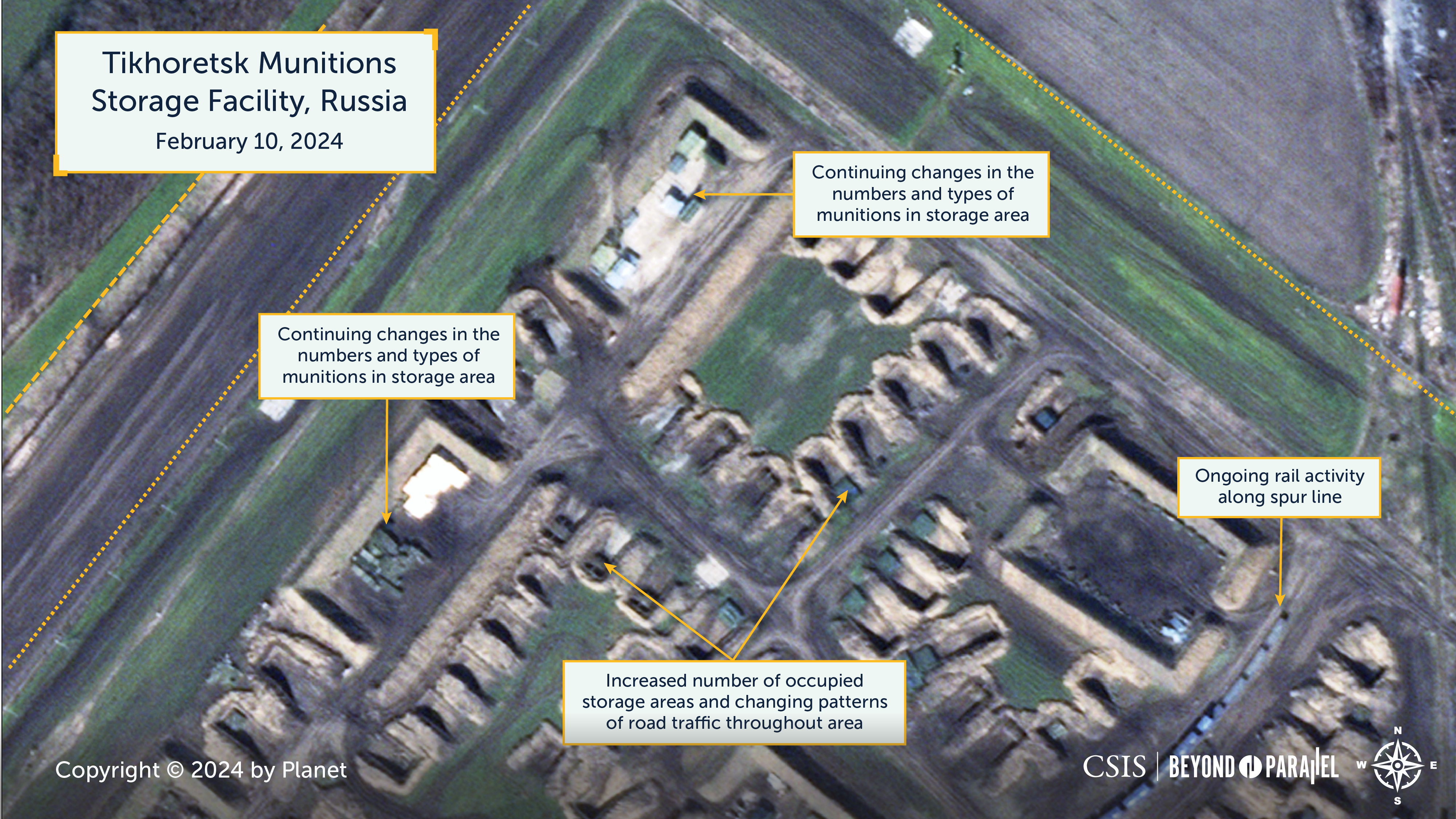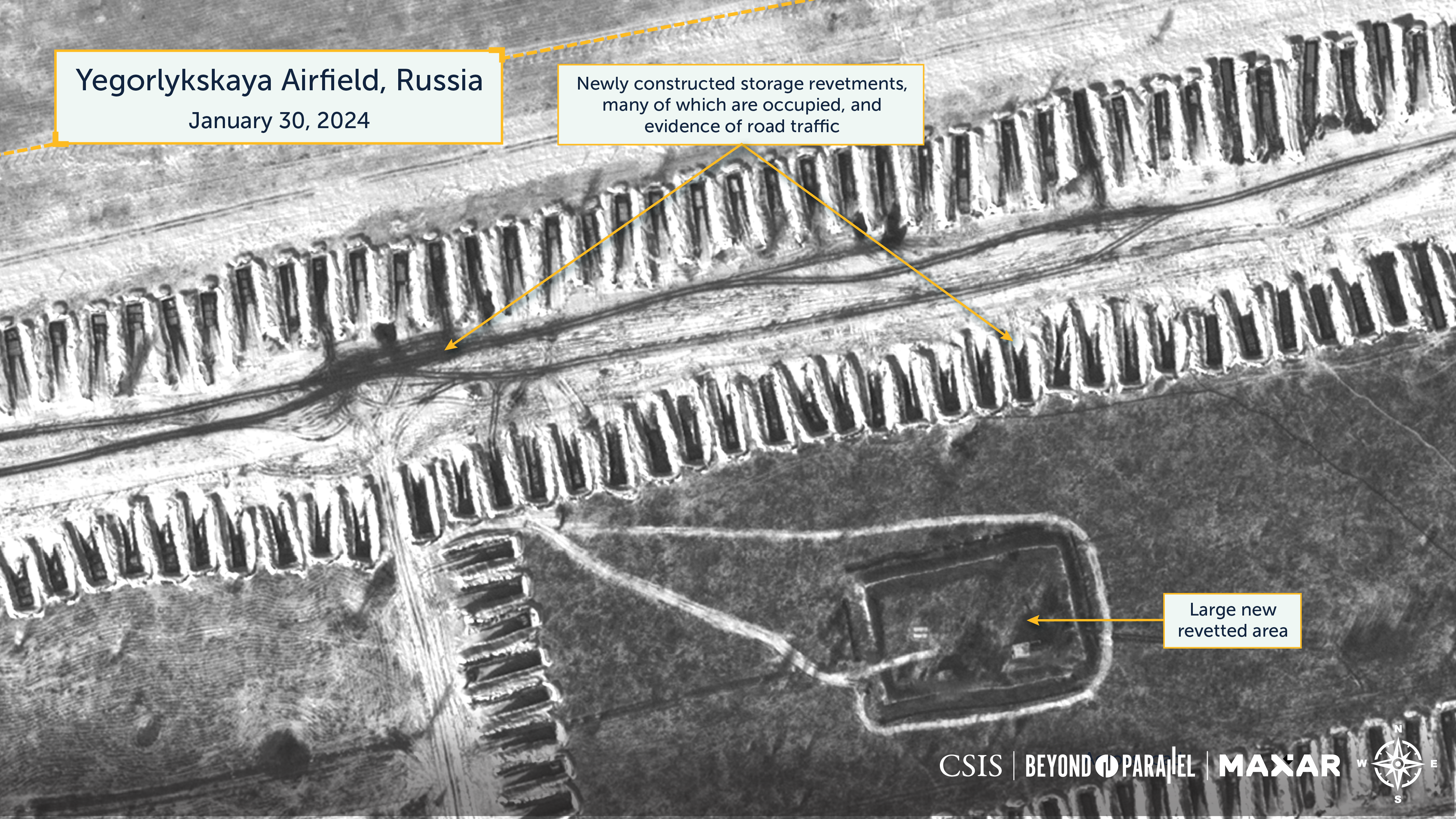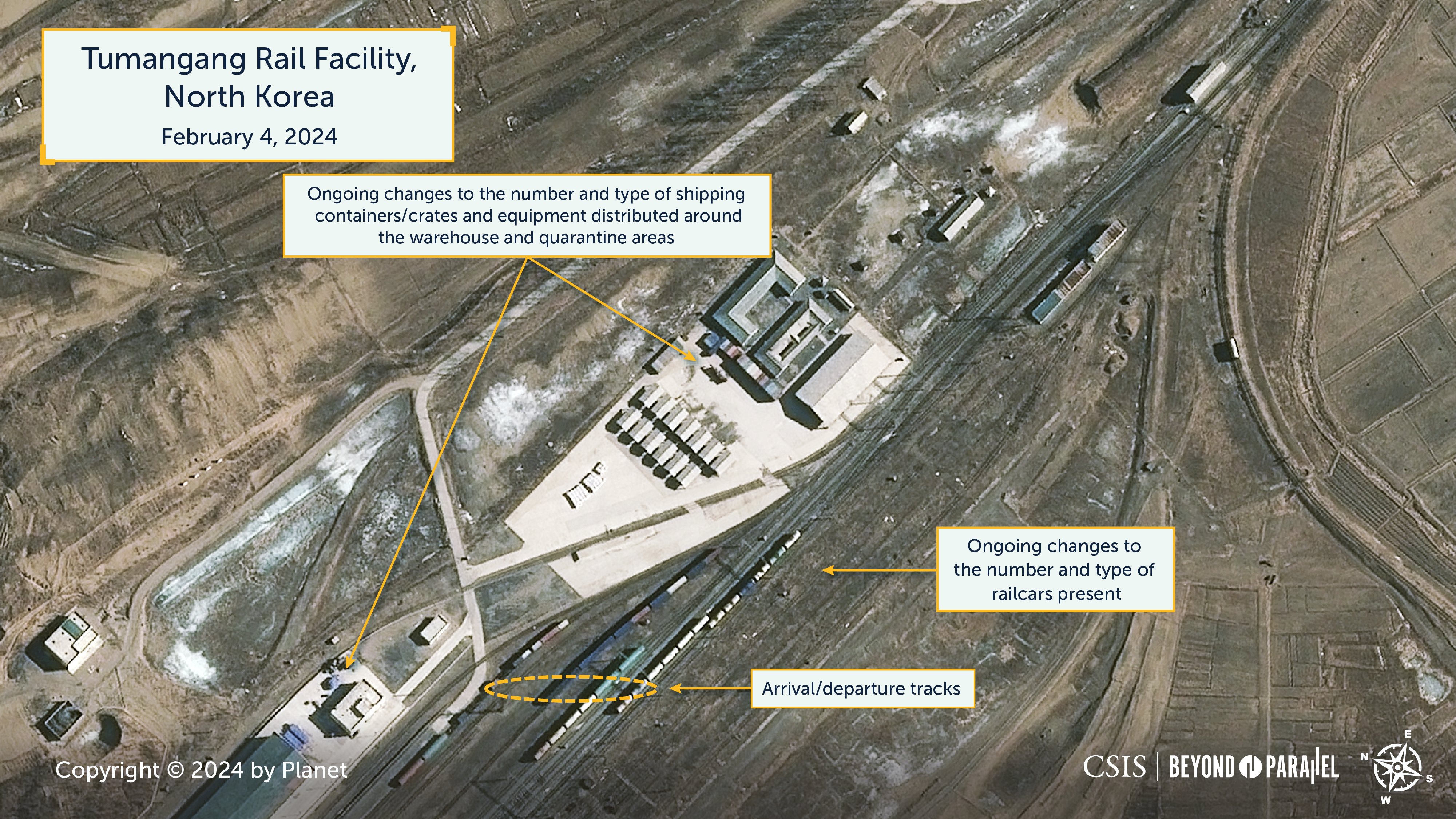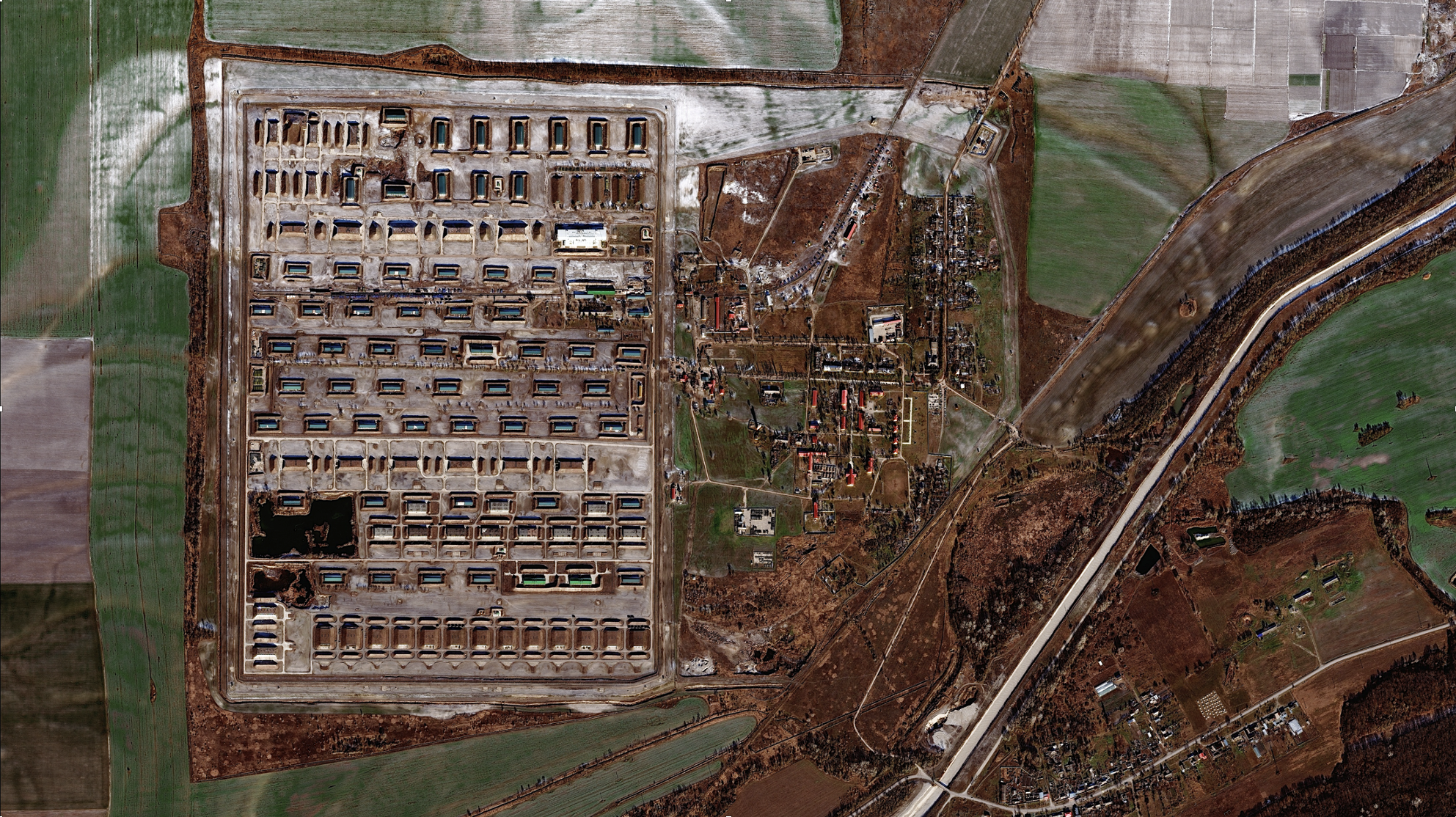
Major Munitions Transfers from North Korea to Russia
Interactive Map of North Korean Munitions Routes to Russia. Zoom to view images and text. For full map view, click here.
Key Findings
- Ammunition supplies have become critical in the Ukraine war. CSIS studied hundreds of commercially available satellite images since August 2023 on the continuing transfer of large quantities of munitions between North Korea and Russia.
- Notably, we find that vessel movement continues between Najin in North Korea and Dunai and Vostochny Port in Russia, along with some changes in vessel activity between these locations since late December 2023. These voyages have reportedly supported the transfer of more than 2.5 million rounds of artillery shells and other munitions.
- We find that since August 2023, there have been at least 25 different visits to Najin for the loading of munitions from North Korea to be delivered to Russia. Additionally, at least 19 “dark vessels” – vessels with their AIS transmissions turned off to avoid outside detection – have visited Vostochny Port in Russia to both unload and load containers from the port.
- There is also active expansion of infrastructure at Tikhoretsk Munitions Storage Facility, Mozdok Munitions Storage Facility, and Yegorlykskaya Airfield, which has been converted into a munitions storage facility to store ammunition closer to the front lines of the war.
- While denuclearization of the DPRK remains the goal of U.S. policy, stopping North Korea’s munitions transfers should become the proximate priority given its implications for the war in Europe and Indo-Pacific security.
- All tools should be considered in such an effort, including PSI-type interception (although the routes used by Russia make this difficult). While sanctions remain the tool of choice (including secondary sanctioning), incentives should also be considered to exploit the DPRK’s innate paranoia of becoming too reliant on any one party for sustenance.
The Ukraine war has “become a battle of ammunition,” as NATO Secretary-General Jens Stoltenberg stated last month as NATO signed an ammunition deal to help replenish Ukraine’s depleted stockpiles.1 Russia, on the other hand, has turned to North Korea and Iran. The transfer of North Korean munitions to Russia began last year, as confirmed by the White House on October 13, 2023. Last month, the White House further stated that a series of North Korean-produced missiles have been fired into Ukraine from Russia, and the South Korean Defense Minister estimated more than 2.5 million rounds of North Korean artillery shells have been supplied to Russia since August 2023.2 The White House also estimated that between September and late February, North Korea has shipped “more than 10,000 containers of munitions or munitions-related materials to Russia.”3 The Ukrainian Prosecutor General has also accused Russia of firing at least 24 North Korean KN-23/24 series missiles in recent weeks.4 In return, North Korea is suspected of seeking a range of Russian military technologies.5
CSIS analysis of hundreds of commercially available satellite imagery since August, along with other open-source information, shows the continuing transfer of large quantities of munitions between North Korea and Russia. Notably, dark vessel movement between Najin (Rason/Rajin) in North Korea and Dunai (Dunay) and Vostochny Port in Russia continues to be observed, along with some changes in vessel activity between these locations since late December 2023.
Additionally, active development and expansion of existing infrastructure in Russia to store the munitions closer to the front lines of the war are observed at the Tikhoretsk Munitions Storage Facility, Mozdok Munitions Storage Facility, and Yegorlykskaya Airfield, which has been converted into a munitions storage facility.
Finally, analysis of satellite imagery was undertaken for both the North Korea-Russia Tumangang-Khasan rail crossing and Vladivostok International Airport to explore the potential use of these locations in ongoing or future transfer operations.
Vessel Movement Between North Korea and Russia: Najin, Dunai, and Vostochny Port

As confirmed by the White House, North Korea’s port of Najin has been used for the delivery of munitions to Russia. Ongoing monitoring showed continuous changes in the number and placement of shipping containers present at the port. From late August 2023 to early February 2024, out of 109 dates when cloud-free commercial imagery of sufficient resolution were captured, there were 49 dates where a vessel likely transporting goods between the two countries was observed at Najin. Further analysis of these images suggests that there have been at least 25 different visits to Najin for the loading of munitions from North Korea to be delivered to Russia. Recent imagery from February 12, 2024, shows continued visits by vessels at Najin.
The two container vessels identified by the Royal United Services Institute in October 2023 as having been involved in these transfers, the ANGARA (IMO 9179842) and the MARIA (IMO 8517839) continued to be observed at Najin during the period studied.6 One such example is on January 8, 2024, when a vessel matching the dimensions and external characteristics of the ANGARA was observed loading containers at the port. Further supporting the identification is that the ANGARA’s AIS (Automatic Identification System) transmission was turned off during the time of the image capture.

The White House identified the Russian military port at Dunai as the destination of vessels traveling from Najin. Analysis of 111 cloud-free commercial imagery from August 2023 to early February 2024 shows 54 dates when a vessel likely transporting goods between North Korea and Russia is observed at Dunai. Vessels are at the port for several days at a time, and there have been at least ten different visits to the location.
Notably, despite consistent and near-daily imagery availability, vessel activity has not been observed at this location from late December 2023 to early February 2024. The reason for the halt in observed activity is unclear at this time. Vessels may continue to visit the port but are avoiding the times of imagery capture. However, this is less likely as vessels that have previously visited the port stayed for several days at a time, making it challenging to avoid near-daily imagery coverage. Alternatively, the port may no longer be used due to inclement weather, increased scrutiny over the location since the White House’s identification of the port as being involved in the transfer or a general slowdown of the pace of transfer as part of the inevitable ebbs and flows of such a wide-ranging operation.
Dark Vessel Activity at Vostochny Port
Since vessels continue to be observed loading and unloading containers at Najin, it begs the question of where these vessels are going if not Dunai. One probable location is Vostochny Port, where NK News identified what appears to be the ANGARA (IMO: 9179842) in October of last year.7
Vostochny Port, a commercial port approximately 60 kilometers east of Dunai, is in the south of Primorsky Krai in Nakhodka Bay.8 AIS data and analysis of commercially available imagery showed that between mid-October 2023 to early February 2024, at least 19 “dark vessels” – vessels with their AIS transmissions turned off – have visited Vostochny Port and have both unloaded and loaded containers during their stay at the port. Turning off AIS transmission, especially at a busy commercial port such as Vostochny Port, indicates a deliberate attempt to avoid outside detection of activity.
On at least five of the 19 instances of dark vessels at Vostochny Port, occasions, a vessel matching the external characteristics of the MARIA, a vessel seen transferring munitions between Najin and Dunai in October 2023, was observed.9 The likely MARIA is observed at Vostochny Port in a Planet image taken on December 25, 2023. Although there is no AIS data available to track the vessel’s previous voyage history, a vessel with the same external characteristics was seen at Najin just four days ago, on December 21, 2023, strongly suggesting that the vessel made a voyage between Najin and Vostochny Port during this time. Previous open-source reporting has identified the MARIA as having traveled between Najin and Dunai. This highly probable voyage in late December indicates that the MARIA is also involved in the transfer of goods between Najin and Vostochny Port.


The MARIA is not the only vessel that is seen traveling between the two countries. A vessel that matches the external characteristics and the dimensions of the MAIA 1 (IMO 9358010), which had been formerly identified by the British Intelligence for being involved in the transfer operations, has been recently observed making voyages between Najin and Vostochny Port.10 An example of such a voyage occurred when the vessel was observed at Najin on February 1, 2024, then at Vostochny Port – with its AIS transmission turned off – four days later on February 5, 2024.


In addition to the two examples above, there are at least three different vessels with distinct external characteristics, seen at Vostochny Port with their AIS transmissions off. It is important to note that in images taken a few hours apart, these dark vessels are seen both unloading and loading containers at the port.
Transport and Storage of Munitions in Russia
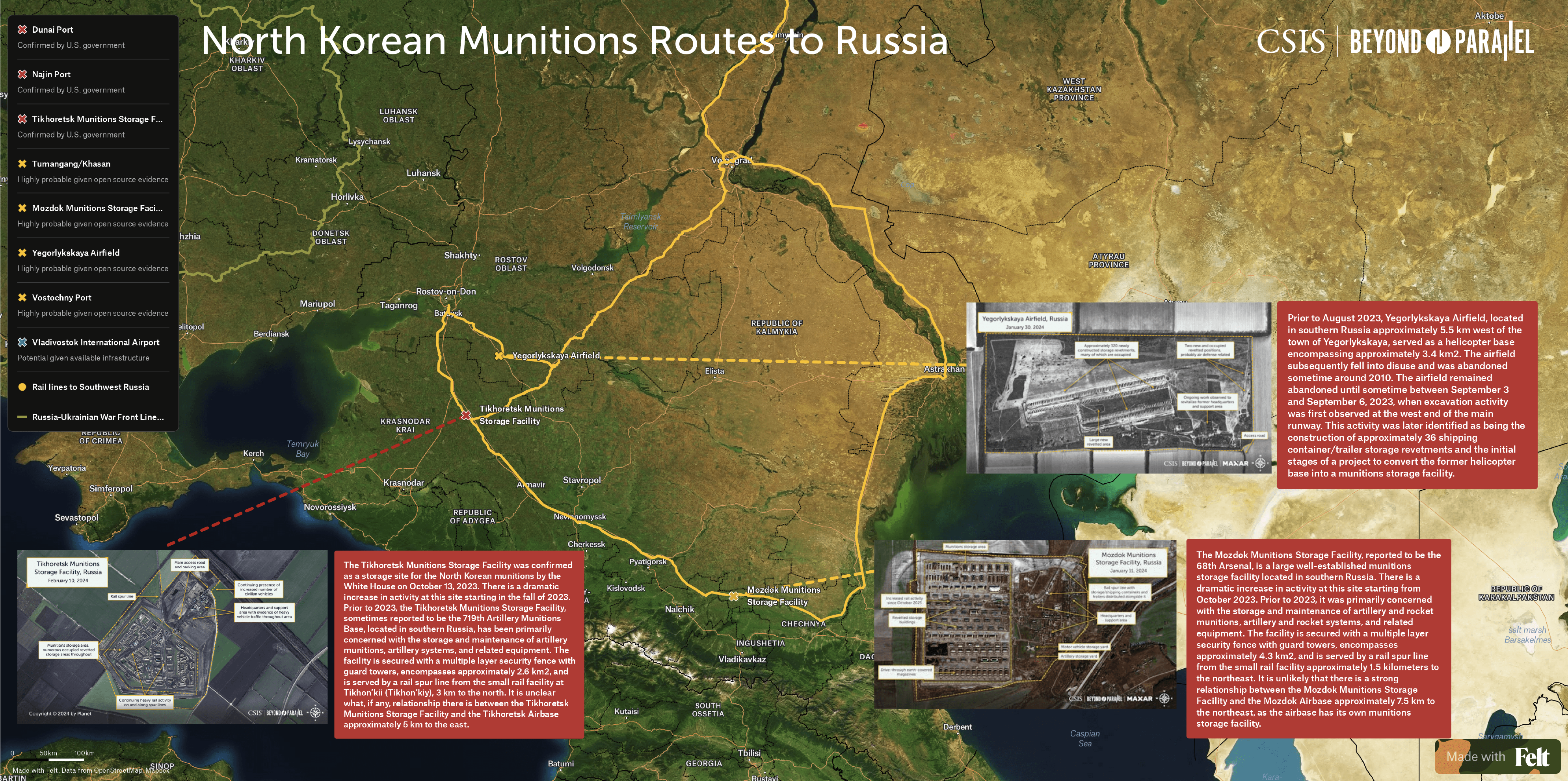
Once delivered to Russia, the North Korean munitions are moved to the west, most likely by rail, and distributed across at least three different locations: Tikhoretsk, Mozdok, and Yegorlykskaya. These strategic storage facilities, located at least 400 kilometers from the border with Ukraine, undoubtedly support operational munitions storage facilities closer to the Ukraine front. These in turn support tactical munitions storage facilities even closer to the front lines. This process follows the Russian military doctrine of “pushing” rather than “pulling” supplies forward. The White House accused Russia last month of having started to use North Korean munitions on the battlefield in Ukraine.11
Tikhoretsk Munitions Storage Facility
The Tikhoretsk Munitions Storage Facility was confirmed as a storage site for the North Korean munitions by the White House on October 13, 2023. There is a dramatic increase in activity at this site starting in the fall of 2023. Prior to 2023, the Tikhoretsk Munitions Storage Facility, sometimes reported to be the 719th Artillery Munitions Base, located in southern Russia, has been primarily concerned with the storage and maintenance of artillery munitions, artillery systems, and related equipment. The facility is secured with a multiple layer security fence with guard towers, encompasses approximately 2.6 km2, and is served by a rail spur line from the small rail facility at Tikhon’kii (Tikhon’kiy), 3 km to the north. It is unclear what, if any, relationship there is between the Tikhoretsk Munitions Storage Facility and the Tikhoretsk Airbase approximately 5 km to the east.
A satellite image collected on August 16, 2023, shows that the facility consisted of two functional areas – headquarters and storage. The headquarters area consisted of headquarters, administration, and maintenance buildings, a motor vehicle/equipment maintenance and repair facility, a small communications facility, an open-air revetted storage area, and small reservoirs. The storage area consisted of approximately four drive-through earth-covered magazines, 27 revetted storage areas, some with buildings, two small reservoirs, two paved open-air vehicle/equipment storage parks, and a spur line with railhead where munitions, artillery systems, and equipment are loaded/unloaded.
In the August 16, 2023, image, there were approximately 27 railcars of different types present along with a modest number of storage/shipping containers and trailers distributed alongside the railroad spur line and main access road. This appears to show a relatively typical Ukraine war level of activity. A small number of civilian vehicles were present at the entrance and access road to the facility. Most notable in the image was excavation activity which had recently begun, with at least 14 locations for what would subsequently become shipping container/trailer storage revetments.
Tikhoretsk Munitions Storage Facility, Russia, on August 16, 2023. The facility, sometimes reported to the 719th Artillery Munitions Base, had begun excavations for what would subsequently become shipping container/trail storage revetements to hold North Korean munitions. (Copyright © 2024 by Maxar Technologies) Image may not be republished without permission. Please contact imagery@csis.org.
Four months later, on December 20, 2023, imagery shows that there has been a dramatic increase in the number of recently constructed shipping container/trail storage revetments, of which there are approximately 280.12 Of these, approximately 50% were occupied. Given the layout and distribution of these new revetments, it is likely that the various groupings represent different classes of munitions, munitions for different field units, or a combination of both.
The number of railcars of various types had tripled to approximately 90. This was accompanied by a dramatic increase in the number of shipping containers/trailers and equipment dispersed alongside the railroad spur line and main access road. Additionally, there was a dramatic increase in the number of civilian vehicles, including trucks, at the entrance and access road to the facility.
Tikhoretsk Munitions Storage Facility, Russia. By December 20, 2023, the facility had approximately 280 storage revetements, half of which were occupied with containers, along with a dramatic increase in equipment and railcars. (Copyright © 2024 by Maxar Technologies) Image may not be republished without permission. Please contact imagery@csis.org.
A more recent satellite image collected on February 10, 2024, shows a modest decrease in the number of railcars present to approximately 80 with approximately 35% of the new revetments occupied, along with the continued movement of shipping containers, trailers, and equipment throughout the facility. Finally, there continues to be a large number of civilian vehicles such as trucks at the entrance and on the access road to the facility. All observed activity suggests that Tikhoretsk remains a strategically important munitions storage facility for southern Russia and the ongoing war in Ukraine.
Tikhoretsk Munitions Storage Facility, Russia, February 10, 2024. (Copyright © 2024 by Planet) Image may not be republished without permission. Please contact imagery@csis.org.
Mozdok Munitions Storage Facility
The Mozdok Munitions Storage Facility, reported to be the 68th Arsenal, is a large well-established munitions storage facility located in southern Russia. There is a dramatic increase in activity at this site starting from October 2023. Prior to 2023, it was primarily concerned with the storage and maintenance of artillery and rocket munitions, artillery and rocket systems, and related equipment. The facility is secured with a multiple layer security fence with guard towers, encompasses approximately 4.3 km2, and is served by a rail spur line from the small rail facility approximately 1.5 kilometers to the northeast. It is unlikely that there is a strong relationship between the Mozdok Munitions Storage Facility and the Mozdok Airbase approximately 7.5 km to the northeast, as the airbase has its own munitions storage facility.
Satellite imagery shows that the Mozdok Munitions Storage Facility consists of two functional areas – headquarters and support, and storage. The headquarters and support area consists of headquarters, administration, and maintenance buildings, a motor vehicle/equipment maintenance and repair facility, several motor vehicle and artillery systems storage facilities, an open-air revetted storage area, a barracks/housing area and two helicopter landing pads. The storage area consists of approximately 37 drive-through earth-covered magazines, 73 revetted storage buildings, 17 open-air revetted storage areas, what appears to be a large maintenance building, two reservoirs, and a railhead where munitions, artillery systems, and equipment are loaded/unloaded.
Satellite imagery collected from August 2023 through January 2024 indicates that there was a significant increase in the number of rail cars, 20-foot shipping containers, shipping crates, and that various supplies began arriving by rail during October 2023.13 Many of these shipping containers along with munitions containers and various supplies were distributed alongside the railroad spur line. Accompanying these developments was a significant increase in the number of cargo trucks moving throughout the storage area and an increase in the number of civilian motor vehicles in the headquarters and support area.
A January 11, 2024, satellite image shows the presence of approximately 36 railcars of different types present along the facility’s rail spur line. Alongside the spur line, there continue to be significant numbers of shipping containers, munitions containers, and various supplies, with an increased number of trucks within the storage area. This is accompanied by increased numbers of civilian vehicles present in the headquarters and support area compared to the previous months. As with Tikhoretsk, the observed activity suggests that Mozdok remains a strategically important munitions storage facility for southern Russia and the ongoing war in Ukraine.
Mozdok Munitions Storage Facility, Russia, on January 11, 2024. The observed activity suggest that Mozdok remains a strategically important munitions storage facility for southern Russian and the ongoing war in Ukraine. (Copyright © 2024 by Maxar Technologies) Image may not be republished without permission. Please contact imagery@csis.org.
Yegorlykskaya Airfield
Prior to August 2023, Yegorlykskaya Airfield, located in southern Russia approximately 5.5 km west of the town of Yegorlykskaya, served as a helicopter base encompassing approximately 3.4 km2. The airfield subsequently fell into disuse and was abandoned sometime around 2010. The airfield remained abandoned until sometime between September 3 and September 6, 2023, when excavation activity was first observed at the west end of the main runway. This activity was later identified as being the construction of approximately 36 shipping container/trailer storage revetments and the initial stages of a project to convert the former helicopter base into a munitions storage facility.

Satellite imagery acquired on January 30, 2024, shows that construction has continued at a fast pace and that there are now approximately 320 revetments of various sizes and types. The majority of these are shipping container/trailer storage revetments aligned along the former runway and taxiways, with others dispersed around the facility’s perimeter. The containers around the perimeter and the large revetted area in the center of the facility may be for an air defense unit.
Construction activity is ongoing as indicated by the vehicle tracks in the snow along the former runway and around the support area. The heavily used access road and the presence of shipping containers, munitions crates, and trailers in the revetments are evidence that the facility is operational and that supplies are being received and shipped out by truck.
Yegorlykskaya Airfield, Russia, on January 30, 2024. The heavily used access road and the presence of shipping containers, munitions crates, and trailers in the revetments are evidence that the facility is operational and that supplies are being received and shipped out by truck. (Copyright © 2024 by Maxar Technologies) Image may not be republished without permission. Please contact imagery@csis.org.
Additional Locations of Interest
North Korea-Russia Railroad Crossing
Satellite imagery of North Korea’s Tumangang Rail Facility at the border with Russia acquired from October 2023 through January 2024 continue to show an unprecedented number of railcars of different types present at the rail facility and across the border at Russia’s Khasan rail facility. As noted in our October 6, 2023 Beyond Parallel report, this level of rail traffic is far greater than that Beyond Parallel observed at the facility between 2019 and 2023, even compared to pre-Covid-19 levels. Although this location has not been explicitly mentioned in the public for being involved in the current series of munitions transfers, it has been previously used to transport “infantry rockets and missiles into Russia” in November 2022.14
A recent high-resolution satellite image collected on February 4, 2024, shows that the higher level of rail traffic continues. At the Tumangang rail facility, the numbers and type of shipping containers/crates and equipment distributed around in the warehouse areas continue to change. As does the number, type, and location of railcars present. At Russia’s Khasan rail facility, the number, type, and location of railcars present also continues to change. Although the seaborne transfer of weapons and munitions to Russia may have quantitatively surpassed that of rail crossing between Tumangang and Khasan, the ongoing level of activity at both rail facilities remains an important indicator of North Korea’s supply of arms and munitions to Russia as well as Russian trade back to North Korea.
Tumangang Rail Facility, February 4, 2024. Higher level of railroad traffic continues. (Copyright © 2024 by Planet) Image may not be republished without permission. Please contact imagery@csis.org.
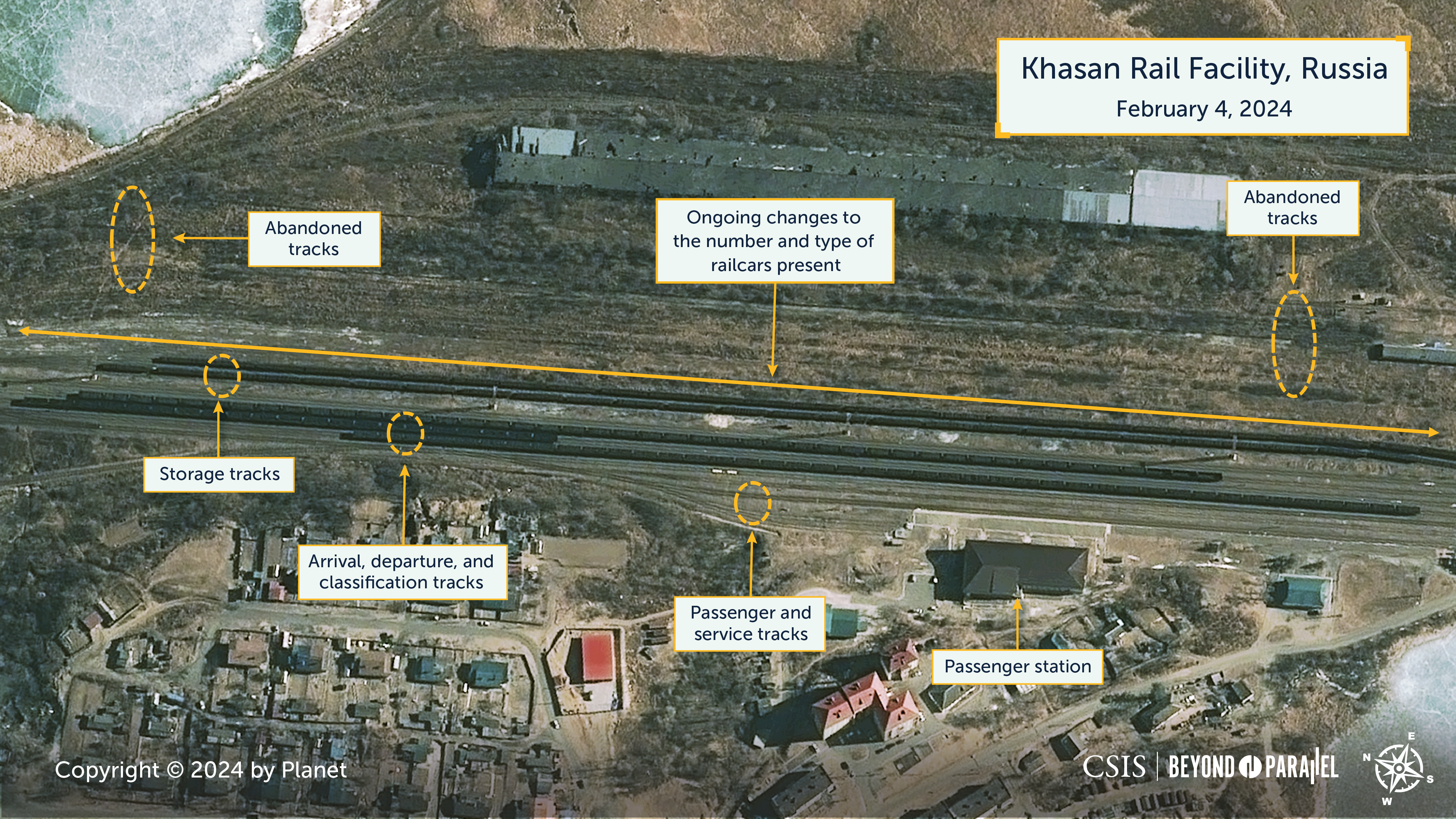
Vladivostok International Airport
The ongoing extensive bidirectional trade agreement being pursued by North Korea and Russia during the past five months, over thousands of kilometers, has likely required the exchange of personnel and coordination from both sides. As such, there is a better than even chance that the Vladivostok International Airport has played some role in both the transportation of North Korean and Russian technicians, logistics, diplomatic, and military personnel, and has potentially included small quantities of critical items and technologies.
In an effort to determine the potential use of the Vladivostok International Airport for the ongoing bidirectional trade agreement, a preliminary review of available satellite imagery was undertaken to compare the number of aircraft present from September 2023 through January 2024 with that from the same period a year ago. Unfortunately, this effort was hampered by poor weather and limited available archives of high-resolution imagery.

The review indicated that except for a minor surge in aircraft present during the first half of September 2023, likely related to Kim Jong-un’s trip to Russia, the number of aircraft present has remained relatively consistent. A comprehensive review of satellite imagery covering activity at the seven military air bases within 170 kilometers of Vladivostok has—except for the September 2023 surge—produced similar findings.
While it will require further investigation, these results suggest that any exchange of personnel and potentially critical components or technology is being satisfied by existing commercial and military air flights from Vladivostok International Airport and/or the existing rail traffic from Vladivostok to western Russia.
References
- “NATO signs 1.1 billion euro contract for 155mm artillery ammunition,” Reuters, January 23, 2024, https://www.reuters.com/business/aerospace-defense/nato-signs-11-bln-euro-contract-155mm-artillery-ammunition-2024-01-23/. ↩
- Michael D. Shear and David E. Sanger, “White House Says North Korea Providing Russia With Ballistic Missiles,” The New York Times, January 4, 2024, https://www.nytimes.com/2024/01/04/us/politics/north-korea-russia-missiles.html; Kim Eun-jung, “Defense chief says N. Korea may supply tactical guided missiles to Russia,” Yonhap News Agency, January 11, 2024, It should be noted that the number provided by the South Korean Defense Minster is likely an indication of the magnitude of the transfer, rather than a precise count. ↩
- Office of the Spokesperson, “Responding to Two Years of Russia’s Full-Scale War On Ukraine and Navalny’s Death,” U.S. Department of State, February 23, 2024, https://www.state.gov/imposing-measures-in-response-to-navalnys-death-and-two-years-of-russias-full-scale-war-against-ukraine/#:~:text=Since%20September%202023%2C%20the%20DPRK,conflict%20since%20early%20October%202023. ↩
- Tom Balmforth and David Gauthier-Villars, “Ukrainian data casts doubt on precision on N. Korea missiles fired by Russia,” Reuters, February 16, 2024, https://www.reuters.com/world/europe/kyiv-says-russia-has-fired-least-24-north-korean-ballistic-missiles-ukraine-2024-02-16/. ↩
- Shear and Sanger. ↩
- James Byrne, Joseph Byrne, and Gary Somerville, “The Orient Express: North Korea’s Clandestine Supply Route to Russia,” RUSI, October 15, 2023, https://rusi.org/explore-our-research/publications/commentary/report-orient-express-north-koreas-clandestine-supply-route-russia. ↩
- Anton Sokolin and Colin Zwirko, “’Russian ship in South Africa arms row appears to aid North Korea weapons trade,” NK News, October 19, 2023, https://www.nknews.org/pro/russian-ship-in-south-africa-arms-row-appears-to-aid-north-korea-weapons-trade/. ↩
- “Карта порта,” Восточный Порт, https://www.vostport.ru/obshchaya-informatsiya/karta-porta/. ↩
- Byrne, Byrne, and Somerville. ↩
- Andrew Roth, “UK sends UN experts photographs of North Korean shipments to Russia,” The Guardian, January 22, 2024, https://www.theguardian.com/world/2024/jan/22/uk-sends-un-experts-photographs-north-korean-shipments-russia. ↩
- Shear and Sanger. ↩
- “North Korean Arms Transfers to Russia,” Maxar Situation Report, Maxar Intelligence, January 2024. ↩
- Tatarigami, “Mapping North Korea’s discreet artillery ammo route to Russia,” Euromaidan Press, January 19, 2024, https://euromaidanpress.com/2024/01/19/mapping-north-koreas-discreet-artillery-ammo-route-to-russia/. ↩
- “Press Briefing by Press Secretary Karine Jean-Pierre and NSC Coordinator for Strategic Communications John Kirby,” The White House, January 20, 2023, https://www.whitehouse.gov/briefing-room/press-briefings/2023/01/20/press-briefing-by-press-secretary-karine-jean-pierre-and-nsc-coordinator-for-strategic-communications-john-kirby-8/. ↩








